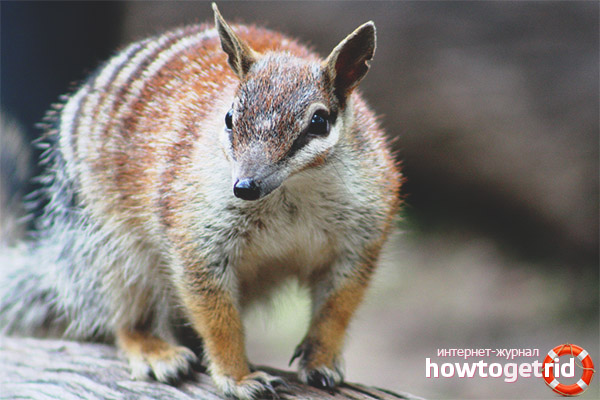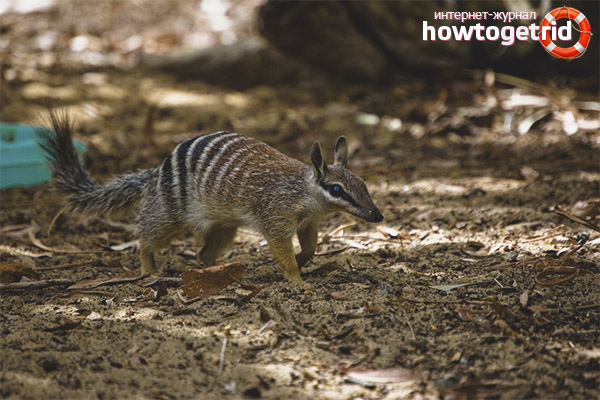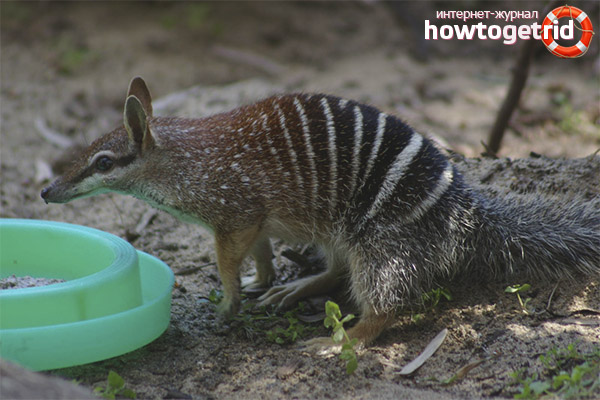The content of the article
Of the exotic animals, the marsupial anteater is one of the most interesting. This cute small animal is capable of eating several thousand termites and ants per day. Hence its name - marsupial anteater. But this representative of the same family has another name - nambat. The marsupial anteater belongs to mammals, and it was first described by the English zoologist George Robert Waterhouse. This happened in 1836, when a scientist studied the unique fauna of the distant Australian continent.
Distribution area
Until the colonization of Australia by Europeans, nambat was very common on the continent. Its settlements were found more in the southern and western parts of Australia, down to the coast of the Indian Ocean. And in the north of the mainland the habitat of this motley marsupial predator extended far, reaching the southwestern regions. But immigrants from Europe brought domestic animals, as well as foxes, to the mainland. All this had a significant impact on the decrease in the number of marsupial anteater. At the same time, the area where the animal could live peacefully decreased.
These days, nambat is found only in Western Australia. Today it predominantly populates eucalyptus forests, as well as places where dry woodland predominates. It is interesting that marsupial anteaters perfectly coexist with koalas, sharing the same habitat with them.
External Distinctive Features
As noted earlier, the nambat is small: for example, the weight of even relatively large individuals does not exceed 500 grams. Moreover, males are much more representatives of the opposite sex. But with such a modest size, this small predator has a very original coloring from bright transverse stripes. It is this feature that distinguishes the animal, and makes it the most attractive of all Australian fauna.
The second characteristic feature unique to nambat is its luxurious, very fluffy tail. In an adult animal, it reaches several tens of centimeters in length, accounting for almost 2/3 of the length of the entire body of the animal.
The anteater’s muzzle is very pretty. It is slightly elongated and pointed. The mouth of the predator is small, in which about fifty asymmetric, weak teeth, which, in principle, do not prevent the animal from successfully hunting.
It should be said about one more anatomical feature of the marsupial anteater, which is related to it with armadillos and other long-speaking representatives of the Australian fauna. This hard palate is relatively longer than the rest of the mammals.
Of the features of the sexual structure, it is worth paying attention to the fact that the female marsupial anteater has four papillae. True, she does not have a brood bag. This organ replaces the milky field, limited by the curling of the hair. The forelimbs of Nambat are five-fingered, have sharp claws, which allows them to have a stable support. The hind legs of the predator are four-fingered.
And at the end of the description of the appearance of this cute animal, I want to dwell a little more on the coloring.Stripes on the animal’s body are light, mostly white-cream tones, and yellow or buffy shades prevail on the abdomen.
What lifestyle does a nambat lead?
Unlike many mammals, the marsupial anteater is more prone to the individual way of life. Each individual has its own plot, the area of which sometimes reaches up to 150 hectares or more. This territory is the food base of the predator. In general, Nambat loves to live in warmth and comfort. Trying to create comfortable living conditions for himself, the animal draws a lot of dry foliage and soft grass into its mink or hollow. In such conditions, he gets enough sleep, and in the morning goes to get food.
The daily activity of a predator largely depends on the ambient temperature. Since in the summer, when warming the soil, all insects hide deep in the ground, the nambat is used to start hunting along with the sunrise. In winter, the animal is active throughout the light cycle until dark. But such performance is more typical for females, and males are content with hunting, which lasts no more than 4 hours. The rest of the time, men prefer to spend in a cozy mink.
Interesting fact! Scientists have found that the anteater’s sleep is more like a state of suspended animation. Due to the fact that the animal literally “falls” into hibernation, it often becomes the prey of larger predators itself. There were even tragic cases when people burned deadwood together with animals that had fallen asleep in it.
But, when the nambat is in a state of wakefulness, he deftly avoids any danger, quickly climbing trees. Interestingly, if you catch a small animal, it does not show aggression at all and does not bite. The anteater expresses his dissatisfaction with a whistle or a peculiar grunt. Many lovers of rare animals tame these cute animals. In captivity, the marsupial anteater lives relatively long - up to 6 years. And in the wild, his life is much shorter.
Diet
The marsupial anteater is considered the only animal of its kind, which prefers eating social insects. These are more termites. Other invertebrate representatives sometimes accidentally fall into his diet. There is evidence that in a day the nambat is able to eat up to 20 thousand insects, which is about 10% of the predator’s own body weight. The hardest time to get food is in the winter, as termites go deep into the ground. Weak claws do not allow the predator to open termite mounds. But when the insects are outside their homes, the goose eater easily gets them with the help of its specific language.
Successfully seek out insects for the animal helps its very delicate sense. The nambat swallows its prey whole, without even bothering to chew on the hard chitinous shell that termites are covered with.
Interesting fact! Not only zoologists, but even occasional witnesses of the meal of the marsupial anteater, argue that the animal completely loses vigilance while eating. Some eyewitnesses to his dinner even tried to take the animal in his arms and stroke him. Against such manifestations of feelings, the anteater did not express the slightest discontent.
The mating season and offspring
Although the anteater’s mating season begins at the end of December, males begin to develop a sexual secret in September that attracts the female. Throughout this period, the males are very active, going in search of a girlfriend, they tend to leave their secret on every bush and tree. But when the meeting still takes place, its duration lasts no more than two days.
Number
As already noted at the beginning of this material, the population of marsupial anteaters is on the verge of complete extinction. A particularly sharp crisis was noted at the end of the 70th of the twentieth century. Scientists believe that the decrease in the number of these representatives of the rare fauna of Australia is most associated with aggressive human activity, which greatly changed the habitat of these small animals. Currently, nambat, as an endangered species, is included in the Red Book.
Video: marsupial anteater (Myrmecobius fasciatus)












Submit